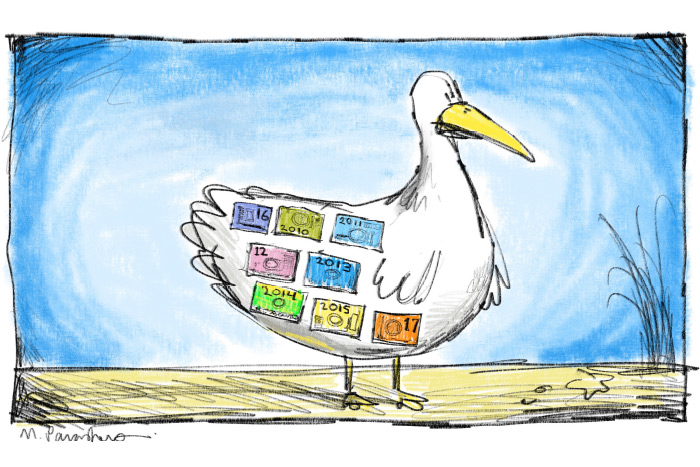East Hampton Beach Sticker Rule May Be About to Change

I have had the same beach sticker on the back of my car for the past 10 years. It’s square, red and faded. It’s been there for 10 years for two reasons. One is that my car, a Tahoe, is 10 years old. The other is that sometimes the town of East Hampton does things pretty special for the local residents here.
Most towns on the East End require that you get a new sticker to go to the beach every year. There’s a fee. The fee covers the cost of making the sticker and enforcing that it be on the car in the required place. Maybe there’s something leftover.
There was a time out here when no towns or villages had beach stickers. There were about 70 road-ends at the beaches. And you just went wherever you wanted to. I think many of the older generation here remember those days. They went back to the very start of the time when people appeared in the Hamptons. First there were barefoot people, then people on horseback, then people in wagons and cars. But when cars began to overflow the lots, something had to be done. So came beach stickers. At a low price for the locals, a higher price for the visitors, and out of date every year.
East Hampton decided on a different rule. For the locals, you get a sticker for free, and you get it just once—even if you move from one part of town to another. It’s good for as long as you own the car. They might have made it forever. But there’s no way to peel a sticker off one car and onto another. So, apologetically, they tell you that you have to get a new free one whenever you get another car. Can’t figure out another way.
This week, however, the East Hampton Trustees began to consider having a beach sticker, still free for the locals, which would have to be renewed every year. This would mean 10 trips to the Trustees in 10 years, not, for example, one.
The cause of this was a piece of testimony that was issued in court by a group of locals who wanted to take ownership away from the general public, which has been the law of the land since the King of England gave us that right back in 1686. This edict is challenged from time to time. They lost. But in the testimony, they pointed out that in the last 10 years more than 3,000 stickers have been given out. So there are a huge number of people—these are the four-wheel drive vehicle stickers—who drive up and down the beach in front of their homes, blocking their view and, some argue, lowering the real estate values.
Are there really 3,000 people who have a sticker to drive up and down the beaches? Of course not. People move away. They sell their cars. They stop using the beach. There are lots of other reasons. Maybe 500 currently might be more accurate. But how would anyone know? The Trustees were now thinking that if they made it an annual free sticker, they’d then know how many people actually do drive on the beach. Or, maybe, they just wouldn’t like to know. What if it were too much? And what would be too much? Fodder for those trying to seize our beaches? They’re working on this. Maybe they should just leave everything alone. If it ain’t broke, don’t fix it.
The person who unleashed beach stickers on the Hamptons was a man named Frank Borth. This was during the Nixon years. All around the country, resorts were putting in beach driving stickers. Would we have to do that too? Maybe there was another way? Borth was a wise old owl in his day. He lived in a small house with a small horse pasture adjacent to Old Montauk Highway in Hither Hills, was a nationally known illustrator and was elected over and over to the Town Board. The Town gave the job to Borth to decide what to do about beach stickers. He spent months working on the problem. He came back with a solution. We’d need beach stickers.
You would have not imagined the confetti of beach stickers that resulted. Quogue had pink ones, Sag Harbor brown ones. Southampton Town orange ones, East Hampton Town blue ones, Southampton Town black ones. And that was just for the towns. Besides the towns there are five villages in the Hamptons, and each needed its own color. Further categories resulted in still further colors. Local residents, motel owners, summer residents, day-trippers.
And that’s what we have today.
It’s an intense thing. There have been occasions when people have made forged beach stickers that they sell to put on cars. Several have been caught doing it. Jail sentences and big fines result, as you might imagine.
Now that I think about it, it’s possible I own the very first beach parking sticker in East Hampton, the one you buy for as long as you own your car.
In 1966, I bought a 1959 English two-seat sports car called a Triumph TR-3. When Frank authorized beach stickers six years later, I got one for this car. It’s still there, in my garage, on the windshield, put there just once, 46 years ago. I charge a small admissions fee to anyone who would like to look at it.
Incidentally, the beach sticker that the Trustees are considering making just an annual affair, is not the regular beach parking sticker for locals, but the particular red beach stickers put on bumpers that identify a vehicle approved for beach driving.
That’s only one of a flurry of 50 or more different beach parking stickers in existence out here. But, if messed with, it could be a start.



